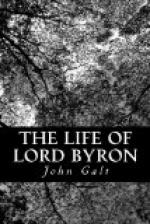“There, in the dead of night, by Donna’s steep, The seamen’s cry was heard along the deep.”
From the ruins of the temple the travellers returned to Keratea, by the eastern coast of Attica, passing through that district of country where the silver mines are situated; which, according to Sir George Wheler, were worked with some success about a hundred and fifty years ago. They then set out for Marathon, taking Rapthi in their way; where, in the lesser port, on a steep rocky island, they beheld, from a distance, the remains of a colossal statue. They did not, however, actually inspect it, but it has been visited by other travellers, who have described it to be of white marble, sedent on a pedestal. The head and arms are broken off; but when entire, it is conjectured to have been twelve feet in height. As they were passing round the shore they heard the barking of dogs, and a shout from a shepherd, and on looking round saw a large dun-coloured wolf, galloping slowly through the bushes.
Such incidents and circumstances, in the midst of the most romantic scenery of the world, with wild and lawless companions, and a constant sense of danger, were full of poetry, and undoubtedly contributed to the formation of the peculiar taste of Byron’s genius. As it has been said of Salvator Rosa, the painter, that he derived the characteristic savage force of his pencil from his youthful adventures with banditti; it may be added of Byron, that much of his most distinguished power was the result of his adventures as a traveller in Greece. His mind and memory were filled with stores of the fittest imagery, to supply becoming backgrounds and appendages, to the characters and enterprises which he afterward depicted with such truth of nature and poetical effect.
After leaving Rapthi, keeping Mount Pentilicus on the left, the travellers came in sight of the ever-celebrated Plain of Marathon. The evening being advanced, they passed the barrow of the Athenian slain unnoticed, but next morning they examined minutely the field of battle, and fancied they had made antiquarian discoveries. In their return to Athens they inspected the different objects of research and fragments of antiquity, which still attract travellers, and with the help of Chandler and Pausanias, endeavoured to determine the local habitation and the name of many things, of which the traditions have perished and the forms have relapsed into rock.
Soon after their arrival at Athens, Mr Hobhouse left Lord Byron to visit the Negropont, where he was absent some few days. I think he had only been back three or four when I arrived from Zante. My visit to Athens at that period was accidental. I had left Malta with the intention of proceeding to Candia, by Specia, and Idra; but a dreadful storm drove us up the Adriatic, as far as Valona; and in returning, being becalmed off the Island of Zante, I landed there, and allowed the ship, with my luggage, to proceed to her destination, having been advised to go on by the Gulf of Corinth to Athens; from which place, I was informed, there would be no difficulty in recovering my trunks.




